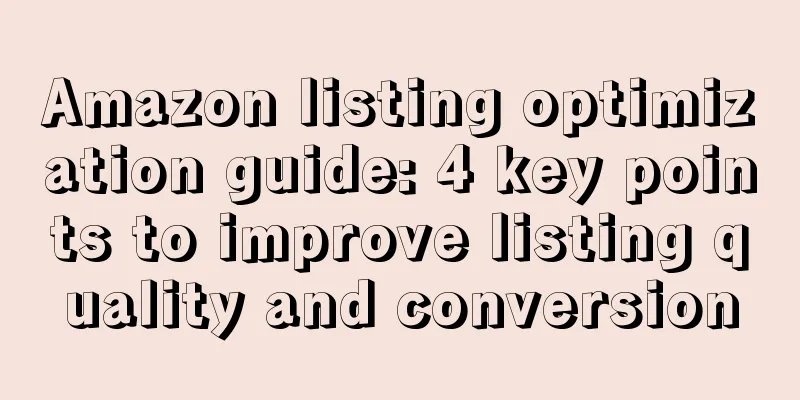On Amazon, increased sales will bring you new sales, and Amazon will improve the ranking of listings that it thinks are more likely to result in sales. While this sounds simple, there are many factors that influence the ranking algorithm for your product, and optimizing a listing is more than just optimizing its appearance.
Here are some considerations you should take into account when creating your listing.
Targeted, buyer-oriented keywords;
Maximize the number of highly relevant keywords indexed;
Focus on what converts and make sure your listing is ready to sell.
Get sales and conversions for your listings as quickly as possible.
01. Targeted, buyer-oriented keywords
Sellers often make mistakes when creating listings, especially when it comes to keywords, which are the basis of the listing.
Not researching keywords carefully
Many listings will only use 5-10 keywords, often around the product’s title, brand, color, flavor, size, and type of use.
But in reality, creating high-quality listings often requires researching thousands of keywords.
Once you have found these keywords, prioritize them based on the following:
product;
Keyword search frequency;
An estimate of the average monthly search volume;
Characteristics of target customers.
You’ll need to research product packaging, company websites, customer reviews, questions customers ask you, and keep in mind questions like:
If customers don’t know your product name or brand, how can they find your product?
You can find keywords by looking at similar search terms, competitor listings, and potential alternative search terms.
Then, put the collected keywords one by one into a tool called Merchant Words for testing.
Merchant Words can help you find other keywords you may not have noticed and determine their approximate average monthly search volume.
You can use the resulting data, along with the search frequency of your keywords, to consider which keywords to prioritize for your listing.
Not understanding the role of keywords
Since customers primarily find products through Amazon searches, keywords are how you target buyers.
This means that you should pay attention not only to the words you use to describe your product, but also to the words your customers might use to describe your product.
For example, suppose you sell office phones. At this time, the person who buys a 6-line PBX office phone is generally a small company, and it may be the office manager or CEO who buys this phone. In this case, they probably wouldn't search for PBX.
However, the person who buys the 12-line office phone may be a technician from a large company, so you should pay more attention to PBX or other technical parameter terms rather than using office phone as a keyword.
02. Increase the number of highly relevant keywords indexed
Being indexed for a term means that your product will be ranked in the search results page for that search term on Amazon. There are several places where you can place keywords to get them indexed.
You need to pay attention to keywords in the following places: title; selling points; background keywords; structured or other data.
Product Title
Amazon has been working to adjust and standardize the way titles appear on Amazon.
Amazon has specific specifications for titles. Optimizing titles for conversions can significantly improve your keyword rankings, rather than abusing keywords in titles.
The title is where you place relevant keywords such as brand name, product name, size, flavor, and words used to describe the product. Keep your title short but descriptive, and avoid overusing keywords.
For most smartphone users, the product title and image will be displayed at the top.
Therefore, your title needs to be highly relevant, clearly state what your product is, and help customers identify your product as a relevant result for their search.
Selling Points
You need to add a brief selling point for your product. It is recommended that each bullet point be kept between approximately 100-250 characters.
You can put a higher number of keywords here. However, your selling points need to be able to attract your target buyers.
Selling points should answer common customer questions such as size, taste, usage, compatibility, materials, and what problems the product solves.
Backstage keywords
The character limit for backend keywords is 250 bytes. You don’t need to repeat any words from your title, bullet points, or other structured data.
Backend keywords can be used to place alternative keywords that you do not want to appear on your products, or words that do not make sense in other data areas.
03. Focus on factors that can lead to conversions
The above are some tips for getting your listing displayed in relevant searches. However, if the listing does not have elements that can bring conversions to the product, then no matter what techniques you use, it will be useless.
If you’re not sure if your product isn’t selling because of a lack of traffic, or isn’t converting because of a lack of traffic, you can view detailed sales and traffic reports to see:
Page views;
Number of visits by buyers;
Order sales percentage;
Gold cart percentage.
Here are some key areas to focus on:
High-quality images
You need to use as many images as possible.
In addition to including product images, use charts to illustrate:
Benefits highlighted in the selling points.
Product variations (e.g., images showing a collapsible luggage bag in both folded and unfolded states).
Images that show the proportions and size of your product.
Photos of the product in use.
Fulfillment Methods/Getting the Prime Badge
Getting the Prime badge can greatly increase your sales. There are currently three ways to get the Prime badge for your products:
Sell products through Amazon Vendor Central;
Using Fulfillment by Amazon in Seller Central;
Participate in Seller-fulfilled Prime through Seller Central.
Pricing
The pricing on your product detail page determines whether you qualify for the Buy Box more than your competitors.
Customers are quick to click the “Add to Cart” button when they’re ready to buy a product, so the majority of purchases on product detail pages will happen with sellers who have a gold shopping cart.
You can view the Buy Box percentage for your product detail pages in the Detail Sales and Traffic reports mentioned earlier in this article.
You also need to pay attention to the prices of your competitors.
You can view detailed sales and traffic reports to determine if competitors are gaining market share due to lower prices.
If your page views and user visits are similar, it means that users are not returning after leaving your listing, which means you need to adjust your price or improve the quality of your listing to increase conversion rate.
A+ Content and Video
If you own a trademark, you can participate in the Brand Registry program, which enables you to add videos and A+ Content. Having A+ Content can increase conversion rates by about 7-11%. Adding videos to the right products can yield even bigger conversion boosts.
Being able to add videos to your listings is one of the many benefits of participating in the Brand Program, and customers who use Vendor Central can also add videos.
evaluate
Sellers used to use reviews to boost rankings, but like any optimization method, marketers took advantage of the loophole and then the loophole was closed.
Most methods of using reviews to improve search rankings are not as effective as they once were. Amazon has reduced the weight that reviews give to boosting its search rankings and has been banning sellers who don’t comply with its review rules.
However, reviews are still very important. Reviews are the piece that holds the flywheel together, letting search engines know that a user entered a search term, viewed a product detail page, made a purchase, and whether the customer liked or disliked the product. Customer reviews ensure that Amazon shows customers the products they want to buy when they search for a certain keyword.
04. Bring sales and conversions to your listing
On Amazon, sales beget more sales. Therefore, after your listing is optimized, you need to get sales to show Amazon that your listing is a good fit for the keywords you are targeting so that you can improve your organic ranking.
Here are a few things you can do to help get that initial sale quickly:
Concentrated traffic
You’ll need to look for duplicate listings and any suitable listings to merge into parent and child variations. Once you make these adjustments, you can focus traffic on a small number of listings, which will naturally improve your products’ rankings.
It is important to note that if the listing category supports variations, make sure to only merge identical listings, and make sure to only merge listings in the form of parent-child variations. Amazon bans sellers who use parent and child variations of products to manipulate sales rankings.
Coupons and Promotions
Since Amazon has reduced the friction for customers to purchase your products as much as possible, there are many ways you can reduce friction to encourage customers to make a purchase, one of which is to offer discounts.
If you’re offering a significant discount, it’s recommended that you use a coupon or promotional code rather than simply lowering the price, as lowering the selling price may cause you to lose the Buy Box, which can affect your long-term sales.

